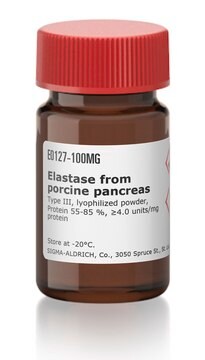C2799
Collagenase from Clostridium histolyticum
powder, suitable for cell culture, ≥4 FALGPA units/mg solid, high purity, ≥700 CDU/mg solid (CDU = collagen digestion units)
Synonym(s):
Clostridiopeptidase A
About This Item
Recommended Products
biological source
Clostridium histolyticum
Quality Level
form
powder
specific activity
≥4 FALGPA units/mg solid
≥700 CDU/mg solid (CDU = collagen digestion units)
mol wt
68-130 kDa
purified by
chromatography
technique(s)
cell culture | mammalian: suitable
pH
7.4
foreign activity
neutral protease and clostripain ≤1 unit/mg solid
shipped in
dry ice
storage temp.
−20°C
Looking for similar products? Visit Product Comparison Guide
Application
Biochem/physiol Actions
Caution
Unit Definition
Preparation Note
related product
substrate
signalword
Danger
hcodes
Hazard Classifications
Eye Irrit. 2 - Resp. Sens. 1 - Skin Irrit. 2 - STOT SE 3
target_organs
Respiratory system
Storage Class
11 - Combustible Solids
wgk_germany
WGK 1
flash_point_f
Not applicable
flash_point_c
Not applicable
Certificates of Analysis (COA)
Search for Certificates of Analysis (COA) by entering the products Lot/Batch Number. Lot and Batch Numbers can be found on a product’s label following the words ‘Lot’ or ‘Batch’.
Already Own This Product?
Find documentation for the products that you have recently purchased in the Document Library.
Articles
Hepatocytes are epithelial cells found in the liver. They perform important functions, such as helping to detoxify blood, and to synthesize transport proteins, such as lipoprotein, albumin and transferrin. Primary and secondary cultures of hepatocytes are useful for studying the mechanisms of liver regeneration and differentiation.
Our team of scientists has experience in all areas of research including Life Science, Material Science, Chemical Synthesis, Chromatography, Analytical and many others.
Contact Technical Service






